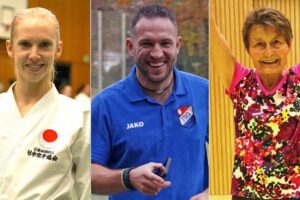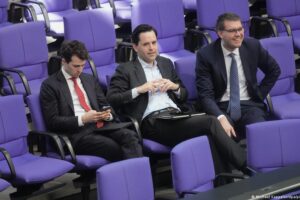
In Germany, where the trains were said to never run late, a route is now considered punctual if it is delayed by less than six minutes. Since 2022, only 62% of trains run right on schedule, compared with close to 99% in neighboring Switzerland. Much longer delays are commonplace, and trips are as likely to be canceled completely as they are to end prematurely. The frequent problems are exacerbated by strikes and weather conditions. If is particularly hot or cold, travelers are likely to encounter more problems.
Train travel in Germany often requires time, patience and nerves of steel. In 2024, Deutsche Bahn (DB) paid passengers almost €200 million ($232 million) in compensation, nearly €70 million more than the previous year.
“Deutsche Bahn is undergoing its biggest crisis in 30 years,” DB CEO Richard Lutz said in May 2025. He has tried in vain to get the company back on track since becoming chairman of the management board in 2017. “We are a long way from what we set out to do and what our customers expect from us, in key areas.”
The run-down DB network covers about 33,500 kilometers (19,800 miles) of track. As a state-owned company, DB is dependent on subsidies from the federal government, which for decades has invested far too little in infrastructure.
“We cannot ensure stable operations on an outdated infrastructure that is prone to failure,” Lutz said.
Experiencing Germany by train — Euromaxx
To view this video please enable JavaScript, and consider upgrading to a web browser that supports HTML5 video
DB infrastructure endeavors
Some of Germany’s tracks, rails, switches and signal boxes date to the 19th century. Many of them are so run down that they cannot be repaired or so outdated that they are not compatible with digitally controlled rail operations that are supposed to become the standard.
DB’s general refurbishment program, which was launched in 2024, focuses on 41 lines, covering 4,200 kilometers, that are essential for a high-performance network. It is the largest overhaulin DB’s history to date.
The 70-kilometer stretch between Frankfurt am Main and Mannheim, known as the Riedbahn, was the first to be shut down. Over six months, rails and ballast, 152 switches and 140 kilometers of overhead line were torn out and reinstalled. Twenty stations, signaling technology and noise barriers were also renovated. It turned out to be more complicated than expected to install digital technology and the costs rose to more than €1.5 billion — twice as much as originally estimated.
The overhaul of Germany’s rail infrastructure is expected to last at least 10 yearsImage: Andreas Arnold/dpa/picture alliance
Explosion of costs
The Federal Audit Office, which reviews the government’s financial management, accused the Transport Ministry of negligence, saying it should have demanded that DB provide evidence for the economic viability of its approach. “The hitherto usual market prices for construction work multiplied within a very short space of time,” the Federal Audit Office wrote to the Bundestag Budget Committee in May. It added that there had also been shortages of skilled workers and construction equipment.
The office determined that further funds for refurbishment plans should only be made available once the Transport Ministry had “prove beyond doubt that these are necessary and economical.”
As a consequence, DB announced that its general refurbishment program would be extended by six years, until 2036.
Closing Berlin-Hamburg line
Next up is the 280-kilometer line between Germany’s largest cities, Berlin and Hamburg, which carries about 30,000 passengers a day, making it the most frequently used direct long-distance connection in the country. It is used by around 230 regional, long-distance and freight trains each day. It will close for nine months from August 1.
Long-distance trains will have to take a detour of 100 kilometers. Freight trains will be rerouted even more extensively. Some 170 buses will replace the regional trains, covering 86,000 kilometers a day to maintain connections to the towns between Berlin and Hamburg. It is already foreseeable that the complications and disruption will be worse than on the Riedbahn.
When there are strikes, there is even more chaos on Germany’s railroadsImage: Bernd Thissen/dpa/picture alliance
DB has considerably scaled back its plans for this massive undertaking. The introduction of the European Train Control System (ETCS), a train protection system to replace the incompatible systems used by European railways, has been postponed until the next decade. This is because conventional technology still needs to be used as not all trains are currently compatible with future systems. A DB press release in May said that this was making the renovation works complicated and costly.
The original number of switches has also been reduced. There were supposed to be more, as well as multiple tracks, to ensure that fast trains could overtake slower ones. Even in the planning stage, the costs have risen to €2.2 billion.
Necessary structural reforms
Germany’s government has promised DB additional funds for the renovation of the rail lines. Federal Transport Minister Patrick Schnieder (CDU) spoke of investments of €107 billion by 2029. The money is to come largely from the debt-financed special fund for infrastructure and climate protection that was established earlier this year.
In a report published in May, the Federal Audit Office warned that the government could not assume that money alone would solve DB’s “permanent crisis.” The office called for an overall strategy that should include an “adjustment” of the company structure, implying that clarity should be brought in to disentangle the hundreds of DB holdings and subsidiaries
For years, there has been a discussion about whether to separate the rail infrastructure and transport in order to enable more private companies and competition in the network. For now, there is little hope that the situation will improve for DB. The Federal Audit Office does not envision that DW will be able “to meet transport and climate policy expectations” for the foreseeable future.
This article was originally written in German.




